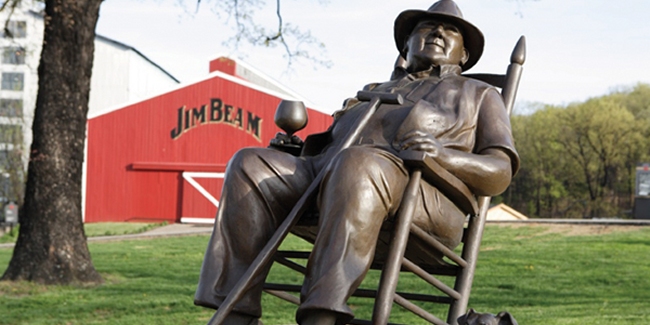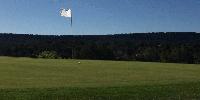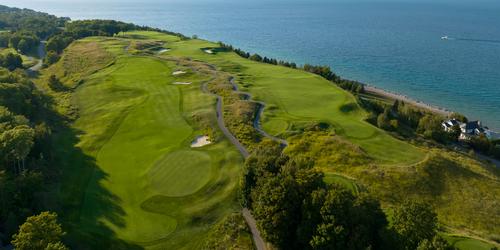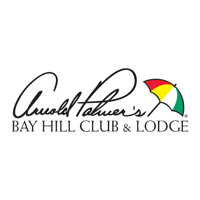
Kentucky Spirit
Bourbon Trail steeps travelers in the lore of the Bluegrass State's renowned bourbon and horseracing industries, granting behind-the-scenes access along the way
By Bruce Leonard
I don't understand why the Bourbon Trail that flows through the rolling hills, bluegrass meadows and tourist-friendly cities in central Kentucky took so long to be established. The trail is as fundamental to understanding the Bluegrass State as limestone is to the creation of whiskey. As Dave Pickerell, vice president of operations and master distiller for Maker's Mark, says, "Bourbon is the place where folklore and heritage and history merge, so as to become indistinguishable."
The Bourbon Trail, in other words, makes perfect sense as an introduction to Kentucky. The route imparts knowledge of the state's past, economy and culture with every scenic mile, and those who venture into any of the seven bourbon distilleries along the way or revel in the horse culture that fortifies the region do not need to drink or gamble to appreciate the wonderful marketing tool that Kentucky's Bourbon Trail will soon become.
More than 200 bourbon distilleries existed in Kentucky in the early 20th century, and perhaps the establishment of an official tour of seven of the remaining 10 distilleries in the state was delayed due to pressure from the religious right. This is, after all, the Bible Belt, and I was surprised on my journey to see a giant billboard along the road that declared, Hell is Real. Now, however, official state-sponsored signs promoting the Bourbon Trail also exist along the interstates. Evidence of the contradiction that is Kentucky abounds, since tobacco, alcohol and gambling (in the form of horseracing) historically and currently make up a huge percentage of the state's economy, and yet not a drop of bourbon has ever been distilled within the present boundaries of Bourbon County, Kentucky.
I learned dozens of such facts on my trip, and, after talking to master distillers, listening to tour guides, watching the bourbon-making process in seven distilleries, from corn delivery to bottling, I believe I've earned the status of apprentice-distiller. Most travelers probably won't immerse themselves so thoroughly, choosing instead to visit two or three of the establishments, then go explore the area's other worthy attractions. Or they can do what I did-act like a sponge.
Bourbon is America's only native spirit, and it resulted from a fortunate accident. Traditional whiskey makers from Pennsylvania moved south to avoid a tax George Washington levied on their liquid livelihood (a tax that fomented the Whiskey Rebellion), and these distillers replaced the rye that was the dominant grain in traditional whiskey with the abundant corn that was raised in response to the Corn Patch and Cabin Rights Act of 1776. Yet only after a Southern Baptist minister, the Reverend Elijah Craig, decided to age, then ship, the liquor he produced in white-oak barrels that had accidentally been charred by fire did whiskey serendipitously become bourbon. Craig loaded his barrels for transport down the Ohio River in Bourbon County, so the barrels received a Bourbon County stamp. During the aging process and transport to New Orleans, the charred wood imparted color and flavor to the whiskey, and soon Crescent City imbibers began demanding "Bourbon County whiskey." The name was shortened, and an industry was born.
Whiskey aged in charred barrels, however, isn't necessarily bourbon. By law, bourbon must be made from a fermented mash of at least 51 percent corn and must age a minimum of two years in charred white-oak barrels that cannot be reused for bourbon production. The bourbon cannot have any color or flavor added to it, unlike other whiskeys, and all the water used by bourbon distilleries has been leeched of iron by Kentucky's ubiquitous limestone. Each distillery swears its unique and highly protected batches of yeast impart unbeatable flavor to its products. Yet since each taster's palate is different, and since bourbon's characteristics must be discovered, explored and savored by the tongue, writing about bourbon is as absurd as-to use Thelonious Monk's famous assessment-"dancing about architecture."
I began my bourbon excursion in Louisville, where the events surrounding the Kentucky Derby infused the air with an energy I've never felt elsewhere. I wandered down the pulsing Fourth Street Live!, downtown's prime people-watching destination and home to Maker's Mark Lounge. The classy establishment was filled with revelers sipping the namesake beverage and enjoying themselves. The lounge is a logical place to begin or end a Bourbon Trail excursion, and trailblazers who like to sip their potent potables in historically rich surroundings should sidle up to the bar in the Seelbach Hotel. F. Scott Fitzgerald used to frequent the bar, and he's believed to have based the bar in The Great Gatsby on this dark, smoky establishment.
Colonel Michael Masters seems like a literary character. He lives in the picturesque bourbon capital of Bardstown, about a half hour south of Louisville, and this southern gentleman mingles bourbon and history in delicious tales that he colloquially imparts to imbibers who visit his Chapeze House, where they'll sample Kentucky's best bourbon. The regal house, circa 1803, imparts class to the proceedings, but when the Colonel serves samples of the state's premium spirits, then waxes poetic about the ethereal aspects each intimates to the palate, a visitor can almost get light headed from the reverence the Colonel displays for Kentucky's finest. No one should, however, ask him to choose a favorite.
RVers who camp only minutes away in lush My Old Kentucky Home State Park may choose to play a round of golf on the adjacent, well-manicured golf course before they set out to determine which distillery tour-and which bourbons-they like best. At Jim Beam's American Outpost, a short drive west of Bardstown in Clermont, visitors can explore the grounds of the world's largest bourbon distiller at their own pace, since the tours are currently self guided. Jim Beam's quantities are staggering, the company storing 1.8 million barrels of bourbon in its rickhouses, and a barrel holds 53 gallons. The tour, however, is of manageable proportions, and in addition to touring the historic T. Jeremiah Beam home, seeing the county's oldest still and the world's smallest working still, visitors can sample a bourbon ball and two small-batch bourbons. Then they can take home a replica poplar bung like the ones used in those 1.8 million barrels.
To receive the best overview of the history of bourbon, travelers should spend time at the Heaven Hill Distilleries Bourbon Heritage Center. The tour of the distillery is not as hands-on as other tours along the Trail, but the Bourbon Heritage Center does such a fine job explaining the bourbon-making process in easily digested sips that travelers who skip this destination in Bardstown are either foolish or grew up in Kentucky and learned all this stuff in grade school.
Maker's Mark Distillery, in the small town of Loretto, about 20 minutes southeast of Bardstown, receives my vote as the distillery to visit if there's only time to explore one. The property itself is so beautiful that if the company produced widgets, travelers would still stop by. Black buildings are highlighted by shutters painted Maker's Mark red, and the shutters feature cut-outs of the company's distinctive bottles. The native Kentucky trees, the stone walls lining the stream that flows through the grounds, the covered bridge and the drive-up Quart House-the oldest standing package liquor store in North America, circa 1889-perfectly complement the intimate tour visitors receive.
Maker's Mark is directly responsible for bourbon changing from traditional, barely drinkable firewater into modern premium products to be savored by sophisticated palates, since the company was the first to introduce a high-end bourbon in 1958. Other manufacturers implicitly acknowledge the double-digit growth of premium and super-premium bourbon by allowing tourists to sample their small-batch and single-barrel bourbons, as opposed to those whose recipes haven't changed for many generations. And, despite another distillery's claim to the contrary, the site Maker's Mark is on is home to the oldest operating bourbon distillery in the world, according to the Guinness Book of World Records. The license to draw water from the creek for the purpose of distilling bourbon was granted September 6, 1805.
The name Four Roses may be familiar to people seasoned enough to have been around when it was the largest selling bourbon in the country. A series of bad business decisions by Four Roses' previous parent company made it nearly impossible for younger people even to hear of the first-rate products made in Lawrenceburg, let alone to buy a bottle. Only a sliver of Four Roses' sales occur stateside, so travelers who want to try a product that is most likely unfamiliar to them-and those who appreciate a well-run, hands-on, fully accessible tour-should be sure to view the Spanish Mission-style architecture and experience the hospitality and quality Four Roses delivers.
Other than Jim Beam, Wild Turkey probably has the highest name-recognition of the distilleries on the Tour. Overlooking the Kentucky River in Lawrenceburg, the Wild Turkey Distillery offers a behind-the-scenes tour that befits its multi-generational imprimatur. A little rough around the edges but still informative and flavorful, this tour is a must for anyone who savors that namesake 101-proof bourbon presided over by that famous bird.
The only location that sang its unparalleled virtues while bad-mouthing the other distilleries' tours or products was Woodford Reserve Distillery. For an operation that tries to position itself as the highest-end, most exclusive distillery on the Tour, this haughty approach was beneath the beauty of the grounds and the quality of the product, and perhaps the powers that be will rectify this unprofessional presentation before more tour-takers are offended.
Offense, however, was nowhere to be found on my tour of Buffalo Trace Distillery. In fact, this was a pleasant experience all around, and Buffalo Trace is the most conveniently located and family friendly distillery, situated only minutes from the attractions of Frankfort, Kentucky's capital, and offering root beer to children or those guests who don't drink. One- and two-hour tours grant different levels of investigation, and one of the aspects of Buffalo Trace that most people will find particularly interesting is that it did not close during Prohibition, making it the oldest continually operated distillery. Prescriptions from that era for "medicinal" whiskey are on display, as are a variety of old, defunct brands. Yet Buffalo Trace delivers far more than novelty, since its bourbons have garnered a host of prestigious awards over the last few years.
Along the Bourbon Trail I learned about semi-permeable membranes, low wine, white dog, the double-distillation process, the inert characteristics of tidewater red cypress and how many seconds it takes to impart a Number 3 char to a white oak barrel-about 40. I learned that bourbon making is both a science and an art, that the premium-product sales are growing at double-digit rates, that George Washington produced rye whiskey and that Abraham Lincoln's father accepted whiskey as partial payment for the sale of his Kentucky farm.
And yet as fascinated as most travelers will be by the Bourbon Trail, they will do themselves a disservice if they don't visit the Kentucky Horse Park in Lexington. This establishment defies a one-word description, since museum, showground and petting zoo don't come close to defining this comprehensive presentation of all things equine, and Kentucky Horse Park simply isn't grand enough. I spent 20 minutes admiring the statue of and reading the plaques about Man o' War.
Guided trail rides, trolley rides, the history of the species, a parade of 50 breeds and 260 paved, water-and-electric sites in the campground are only a few of the reasons to visit the Kentucky Horse Park's 1,200 acres. Anyone who has ever placed a bet on a horse and all fans of opulence should sign on with Shaun Washington for his Unique Horse Farm Tours. Shaun drives an air-conditioned van through Bluegrass Country, along scenic back roads to private horse farms so ornate that many of the barns are worth more than a million dollars. The horses inside, of course, are worth far more.
As my Bourbon Trail tour wound down, I realized that the Trail couldn't have been established any sooner. People in Kentucky understand that everything has to age just so-be it a lively three-year-old Thoroughbred or a 12-year-old single-barrel bourbon.
Bourboncountry.travel (888) LOUISVILLE
Visitbardstown.com (800) 638-4877
myoldkentuckyhomestatepark.com (502) 348-3502
jimbeam.com (502) 543-9877
bourbonheritagecenter.com (502) 337-1000
makersmark.com (270) 865-2099
fourroses.us (502) 543-2264
wildturkeybourbon.com (502) 839-4544
woodfordreserve.com (859) 879-1812
buffalotrace.com (800) 654-8471
kyhorsepark.com (859) 233-4303
Unique Horse Farm Tours (800) 678-8813
Revised: 11/28/2011 - Article Viewed 42,789 Times
About: Bruce Leonard
![]() Bruce Leonard has been a freelance writer/photographer specializing in adventure travel for two decades, his work having been published in dozens of publications, including the Robb Report, Playboy, Travel+Leisure Golf, National Parks and the L.A. Weekly. His first solo art show recently closed, and his writing, photos and paintings can be found at freelanced.com/bruceleonard.
Bruce Leonard has been a freelance writer/photographer specializing in adventure travel for two decades, his work having been published in dozens of publications, including the Robb Report, Playboy, Travel+Leisure Golf, National Parks and the L.A. Weekly. His first solo art show recently closed, and his writing, photos and paintings can be found at freelanced.com/bruceleonard.














